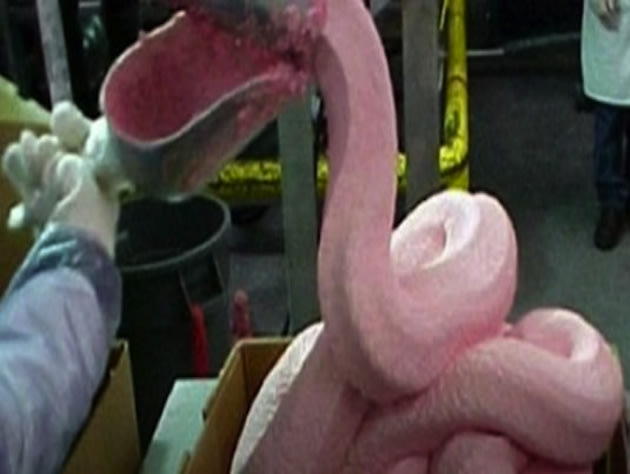McDonald’s confirms that it’s no longer using ‘pink slime’ chemical in hamburgers
 Ammonium hydroxide, image from KSDK TV
Ammonium hydroxide, image from KSDK TV
McDonald's announced last week that, as of last August, is has stopped using ammonium hydroxide in the production of its hamburgers. MSNBC reports that the chemical, used in fertilizers, household cleaners and even homemade explosives, was also used to prepare McDonalds' hamburger meat.
And while the announcement is making headlines, you may (or may not) want to know about some other unusual chemicals being used in the production of some of our most-popular foods:
The International Business Times lists some other questionable chemicals showing up in our foods:
Propylene glycol: This chemical is very similar to ethylene glycol, a dangerous anti-freeze. This less-toxic cousin prevents products from becoming too solid. Some ice creams have this ingredient; otherwise you'd be eating ice.
Carmine: Commonly found in red food coloring, this chemical comes from crushed cochineal, small red beetles that burrow into cacti. Husks of the beetle are ground up and forms the basis for red coloring found in foods ranging from cranberry juice to M&Ms.
Shellac: Yes, this chemical used to finish wood products also gives some candies their sheen. It comes from the female Lac beetle.
L-cycsteine: This common dough enhancer comes from hair, feathers, hooves and bristles.
Lanolin (gum base): Next time you chew on gum, remember this. The goopiness of gum comes from lanolin, oils from sheep's wool that is also used for vitamin D3 supplements.
Silicon dioxide: Nothing weird about eating sand, right? This anti-caking agent is found in many foods including shredded cheese and fast food chili.
So, what moved McDonald's to make the change in their hamburger production? In a statement posted on its website, McDonald's senior director of quality systems Todd Bacon wrote:
"At the beginning of 2011, we made a decision to discontinue the use of ammonia-treated beef in our hamburgers. This product has been out of our supply chain since August of last year. This decision was a result of our efforts to align our global standards for how we source beef around the world."
The U.S. Agriculture Department classifies the chemical as "generally recognized as safe." McDonald's says they stopped using the chemical months ago and deny the move came after a public campaign against ammonium hydroxide by celebrity chef Jamie Oliver.
You can watch video of Jamie Oliver showing the process of using ammonium hydroxide on meat here:
The food industry uses ammonium hydroxide as an anti-microbial agent in meats, which allows McDonald's to use otherwise "inedible meat."
On his show, Oliver said of the meat treatment: "Basically we're taking a product that would be sold in the cheapest form for dogs and making it 'fit' for humans."
Even more disturbing, St. Louis-based dietician Sarah Prochaska told NBC affiliate KSDK that because ammonium hydroxide is considered part of the "component in a production procedure" by the USDA, consumers may not know when the chemical is in their food.
"It's a process, from what I understand, called 'mechanically separated meat' or 'meat product,'" Prochaska said. "The only way to avoid it would be to choose fresher products, cook your meat at home, cook more meals at home."
No comments:
Post a Comment